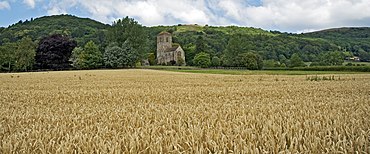
Back حماية على مستوى مشهد بصري Arabic Landschaftspflege German حفاظت در مقیاس چشمانداز Persian Maisemanhoito Finnish Landschapsbeheer Dutch د طبیعي منظر ګوټ ساتنه Pashto/Pushto Manažment krajiny Slovak Landskapsvård Swedish

Landscape-scale conservation is a holistic approach to landscape management, aiming to reconcile the competing objectives of nature conservation and economic activities across a given landscape. Landscape-scale conservation may sometimes be attempted because of climate change. It can be seen as an alternative to site based conservation.
Many global problems such as poverty, food security, climate change, water scarcity, deforestation and biodiversity loss are connected.[2][3] For example, lifting people out of poverty can increase consumption and drive climate change.[4] Expanding agriculture can exacerbate water scarcity and drive habitat loss.[5][6] Proponents of landscape management argue that as these problems are interconnected, coordinated approaches are needed to address them, by focussing on how landscapes can generate multiple benefits. For example, a river basin can supply water for towns and agriculture, timber and food crops for people and industry, and habitat for biodiversity; and each one of these users can have impacts on the others.[2][3][7]
Landscapes in general have been recognised as important units for conservation by intergovernmental bodies,[8] government initiatives,[9][10] and research institutes.[11]
Problems with this approach include difficulties in monitoring, and the proliferation of definitions and terms relating to it.[3]
- ^ Cite error: The named reference
Phillips 2005was invoked but never defined (see the help page). - ^ a b Cite error: The named reference
LSLBwas invoked but never defined (see the help page). - ^ a b c Cite error: The named reference
learningwas invoked but never defined (see the help page). - ^ Stern, N (2007). The Economics of Climate Change: the Stern Review. Cambridge UK: Cambridge University Press.
- ^ Tilman, D (1999-05-25). "Global environmental impacts of agricultural expansion: the need for sustainable and efficient practices". Proc. Natl. Acad. Sci. USA. 96 (11): 5995–6000. Bibcode:1999PNAS...96.5995T. doi:10.1073/pnas.96.11.5995. PMC 34218. PMID 10339530.
- ^ Laurance, W F; Sayer, J; Cassman, KG (2014). "Agricultural expansion and its impacts on tropical nature". Trends in Ecology & Evolution. 29 (2): 107–116. doi:10.1016/j.tree.2013.12.001. PMID 24388286.
- ^ Hart, A K; McMichael, P; Milder, J C; Scherr, Sara J (2015). "Multi-functional landscapes from the grassroots? The role of rural producer movements". Agriculture and Human Values. 33 (2): 305–322. doi:10.1007/s10460-015-9611-1. S2CID 153211771.
- ^ Cite error: The named reference
SBSTTA reportwas invoked but never defined (see the help page). - ^ Cite error: The named reference
GMS BLLwas invoked but never defined (see the help page). - ^ Cite error: The named reference
IINDCwas invoked but never defined (see the help page). - ^ Cite error: The named reference
CIFOR landscapes pgwas invoked but never defined (see the help page).
© MMXXIII Rich X Search. We shall prevail. All rights reserved. Rich X Search